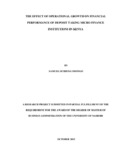| dc.description.abstract | Operational growth is critical to modern day organizations even for microfinance sector, but
achieving operational growth can be a challenge for even the most ambitious organizations.
Deposit Taking microfinance institutions experiences an enduring problem how to attain
operational growth and financial performance. The objective of this study is to determine the
effect of operational growth on financial performance of Deposit Taking Microfinance
Institutions in Kenya. Even though some researches have been conducted on this area of study,
the problem has attracted attention of numerous researchers in recent past and as a result many
strategies have been put in place to ensure operational growth. A descriptive research design was
used in this study. The study focused on 12 licenced DTMFIs in Kenya. The researcher obtained
secondary data for four years (2010-2014) from the Association of Microfinance Institutions
(AMFI), Central Bank of Kenya (CBK) and published newspapers, and the DTMFIs‟ websites.
The data analysis method to be used was based on quantitative approach using descriptive
statistics and inferential methods which include; measures of central tendency (mean, median,
mode), measures of dispersion (range, variance, standard deviation,), measures of relative
position and measures of relations and associations, correlation and regression. The regression
analysis established that the four independent variables (operational growth, operational capital,
branch network, and customers served) have a positive correlation with the dependent variable
(financial performance). A positive correlation between the study variables was established by
R-square value of 0.013. ANOVA analysis findings established that that there was correlation
between the predictor variables, including operational growth, operational capital, branch
network, and number of customers served; and response variable, which is the financial
performance since P- value of 0.888 (88.8%) at 0.95 (95%), which revealed a positive
relationship between the variables used in this study. The study therefore recommends that further studies should be carried out in future when the DTMFIs have been in existence for a
longer period. | en_US |

